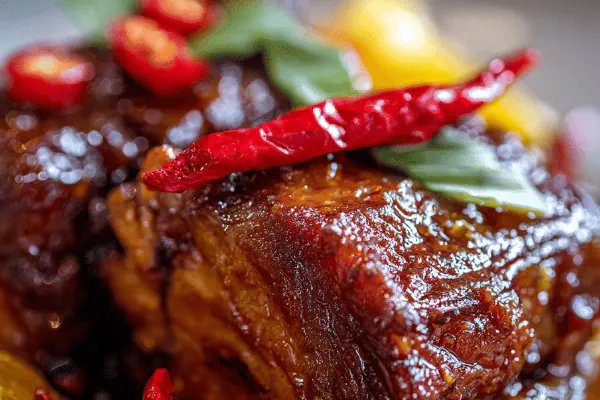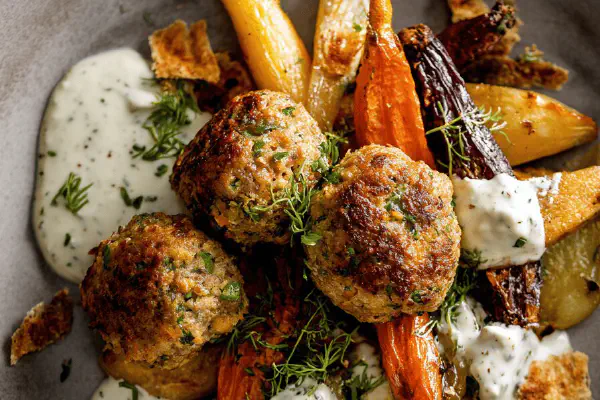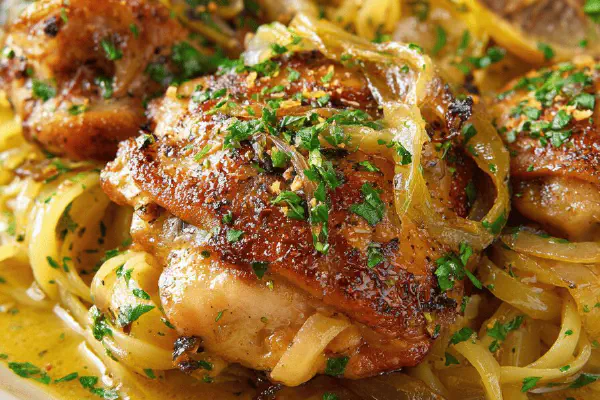Braised Pork Shoulder Orange Cinnamon

E
By Emma
Certified Culinary Professional
•
Recipe tested & approved
Large pork shoulder slow braised in citrus and spices. Orange juice and rice vinegar add brightness, balanced by cinnamon and lemongrass. Ginger and dried chilis bring warmth and heat. Cassava sugar replaces brown sugar for a subtler sweetness. Chicken broth or water keeps it moist. Meat falls apart easily after slow cooking. Serve alongside jasmine rice and sautéed greens for full meal.
Prep:
40 min
Cook:
Total:
Servings:
8 servings
#pork
#braised
#citrus
#dinner
#comfort food
Orange and cinnamon. Not typical for pork shoulder but it works. Bright citrus juice brightens a fatty cut. Rice vinegar cuts through richness with a subtle tang. Lemongrass and galangal add earthy, citrusy tones—both often overlooked in slow braises. Bird’s eye chilis for a sharp kick of heat. Slow cooking for hours—three hours plus a bit. Magic happens. The meat softens until it pulls apart effortlessly. A thick, syrupy sauce forms from the braising liquid, sticky with citrus sugar and savory tamari. Off-the-beaten path flavors that still feel comforting. Goes well with plain jasmine rice, maybe quick sauteed greens to balance richness. No fuss. Just slow, steady, and intense flavor build-up.
Ingredients
- 1.4 kg pork shoulder roast, deboned and loose
- 25 ml olive oil
- 1 large onion, thinly sliced
- 3 cloves garlic, minced
- 3 ml turmeric powder
- 200 ml fresh orange juice
- 240 ml chicken stock or water
- 130 ml rice wine vinegar
- 140 ml cassava syrup
- 60 ml tamari sauce
- 1 medium blood orange, sliced and seeded
- 2 small cinnamon sticks
- 3 slices fresh galangal, peeled
- 40 ml finely chopped lemongrass
- 2 whole dried bird’s eye chilis
- Salt and freshly ground pepper
About the ingredients
Cut the pork shoulder wisely. A leaner piece won’t have that melt-in-your-mouth effect after braising. Opt for about 1.4 kg to keep portions generous but manageable. Cassava syrup replaces brown sugar for a less caramelly, lighter sweetness—easier to find in specialty stores or online. If unavailable, honey or maple syrup works but changes flavor slightly. Galangal slices swapped in place of ginger for a sharper, more peppery feel. Fresh lemongrass finely chopped releases intense aroma unlike dried powder. Dried bird’s eye chilis provide controlled heat—remove easily after cooking, or substitute with fresh if preferred, just watch spice levels. Tamari adds soy richness but keeps it gluten-free. Rice wine vinegar for a gentle, nuanced acidity instead of plain vinegar.
Method
- Arrange rack in middle oven slot. Heat oven to 175 C (347 F).
- Heat oil in large dutch oven over medium. Brown pork roast on all sides. Season with salt and pepper. Remove pork, set aside.
- In same pot, sweat onions and garlic with turmeric for 3 minutes until softened but not colored.
- Add orange juice, chicken stock, vinegar, cassava syrup, tamari, orange slices, cinnamon sticks, galangal, lemongrass, and dried chilis.
- Return pork to pot, nestle in the liquid. Bring to a boil.
- Cover pot tightly. Put in oven and braise about 3 hours 10 minutes, until meat is fork tender and nearly falling apart.
- Turn pork every 60 minutes during cooking to promote even flavor and color.
- Remove cinnamon sticks, galangal slices, and chilis from pot.
- Optional degrease cooking liquid by spooning off excess fat.
- Serve shredded meat with jasmine rice and sautéed broccoli or greens.
Cooking tips
Preheat oven to 175°C for a slower braise, which makes pork tender while retaining moist texture. Browning meat first seals in juices and adds rich flavor. Use a heavy pot that withstands oven heat and holds moisture well. Sweating onions and garlic with turmeric releases mellow aromatics before adding liquids. Bring the braising liquid to boil so flavors start melding early on. Cover tightly for even cooking—foil under lid possible if not tight sealed. Turn pork at least three times during cooking to distribute liquid and promote even seasoning. After removing whole spices, skim off fat if desired to reduce greasiness but some fat keeps sauce luscious. Serve immediately or cool and refrigerate—the flavor deepens overnight. Reheat gently to avoid drying meat. Accompany with neutral sides like jasmine rice or mild sautéed vegetables to absorb and balance the robust sauce.
Chef's notes
- 💡 Consider the pork cut carefully. Leaner meat doesn't break down. Go for 1.4 kg for the best texture. Fat keeps it juicy. Always choose well for best results.
- 💡 Use cassava syrup instead of brown sugar. It adds sweetness without overpowering flavor. Honey or maple works too, but taste changes. They filter sweetness differently.
- 💡 Turning the pork is essential. At least every 60 minutes. It helps flavors mix evenly. Keeps it moist too. Don’t skip this part for ideal results.
- 💡 After cooking, remove those whole spices like chilis. They overpower if left. Skimming fat is optional. Some grease keeps the sauce rich. But too much? Not ideal.
- 💡 Refrigerating leftovers deepens flavor. Keep it chilled. Reheat gently. High heat dries meat. Ensure it stays moist while reheating. Pair with neutral sides.
Common questions
How do I know when the pork is done?
Fork tender checks. Meat should easily fall apart. If tough, needs more time, turn up heat slightly.
Can I make this ahead of time?
Yes. Prepare the day before. Let flavors meld overnight. Reheat thoroughly, avoid drying it out.
What's an alternative to tamari?
Soy sauce can work as well. But adds gluten. Adjust flavor according, soy tastes bolder.
Is there a way to preserve leftovers?
Store in airtight containers. Freeze if you won’t use within a week. Defrost slowly in fridge.



